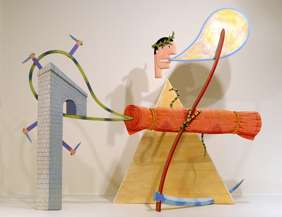Education professor shows art, museums can be key to boosting literacy across subjects

When it comes to education in reading and writing, many think of burying their noses in books or English composition assignments. One might not consider a trip to an art museum as a way to bolster students' literacy, but a University of Kansas professor has shown that art can be a highly effective way to engage students in literacy, especially those who struggle with it otherwise, and that it can apply to subjects as varied as math, science, social studies and, of course, English.
Arlene Barry, associate professor of curriculum and teaching, is a former middle school teacher who often worked with students who struggled with reading and writing. When one student who vocally refused to read became interested in a book of art prints she kept in her office, she realized art could be a gateway to literacy for young learners.
"It was often very difficult to get those students to be interested at all in reading and writing," Barry said. "I found as I started using artworks with kids who were frozen in reading and writing, it was a way to get them motivated and taking part in exercises like describing the picture, what the people in it are feeling, if they would like to go to that place and so many other things."
Now an educator who works with students training to become teachers, Barry regularly takes her reading and writing across the curriculum classes to Spencer Museum of Art. The pre-service teachers view selected works of art and develop ways they could engage students in reading and writing exercises based on the pieces. Paintings, sculptures, quilts, mosaics and other artworks are paired up with subjects from math to science to social studies and foreign languages. The practice has proven popular, and Barry has published a series of journal articles about how art museums can help teachers boost literacy and how a survey of her former students showed that as many as half of them still regularly use such methods in their classrooms.
Barry acknowledges in her articles that content reading is not exactly a popular course. The students who take it are often gifted in their areas of expertise and don't naturally identify with others who may have difficulty reading or writing about mathematics, for example. Students have reported, however, that viewing their subjects through the lens of art has given them a new perspective on their areas of specialty and opened them to new ideas about them.
"The art can often be controversial, and that can get them thinking, talking, arguing and making them want to find more information to prove their points," Barry said of the students who take the course and the future students they teach.
While not every teacher has access to a world-class facility like the Spencer museum, Barry said her students have reported they have had success partnering with presidential libraries, natural history museums or viewing community art such as murals or finding art online and designing educational opportunities around them. The association of art and literacy is also a way for teachers to break away from over-reliance on textbooks, Barry said.
Emphasizing literacy and the ability to read and write in any subject is increasingly important as Common Core standards are adopted across the country, Barry said. The standards' increased emphasis on reading and writing will mean more challenging texts are included in classes, and students who struggle in the area will be challenged even further. But that can also be an opportunity.
"We're going to have more and more students struggling with the text," Barry said. "There's not only one way to learn. We as educators need to use multimodal experiences to reach all students in a more holistic way."
Provided by University of Kansas


















